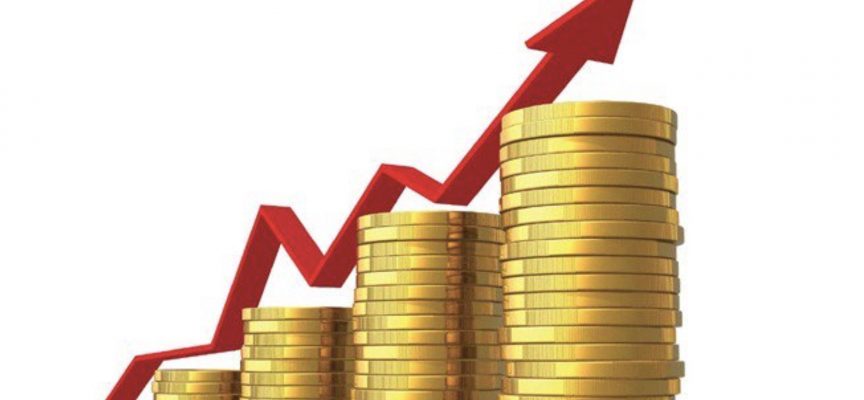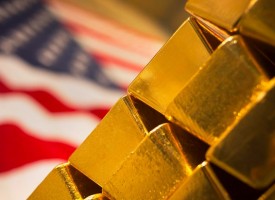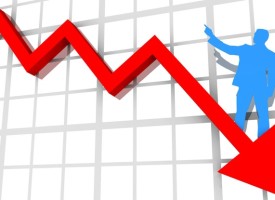With stock markets trading higher and the US dollar attempting to stabilize, today a legend in the business sent King World News a powerful piece stating this is going to send the price of gold above $2,000.
Gold’s Price Set To Soar
By John Ing, Maison Placements
February 16 (King World News) – In January the stock market recorded all-time highs in its strongest start since 1987, as investors gave a “thumbs up” to the Trump growth agenda of massive tax cuts, infrastructure spending and a loosening of regulations. Business too gave a “thumbs up” for an economic recovery that was tentative for so long but finally is taking root. And, few care that Mr. Trump’s spending and slashing of taxes would cause deficits to balloon by almost $2 trillion, forcing the Treasury Department to double its borrowings this year to $1 trillion. Trumponomics seems good for both the good and bad times.
Yet the dollar headed for new lows on the prospect of trillion dollar deficits meaning more money printing and the debasement of the very currency held by all central banks and foreign investors. And then in February, the Dow erased the January gains sparking a global correction across Europe and Asia. The roller-coaster ride was a belated recognition that the pickup in bond yields, accompanied by stronger economic growth is the beginning of the end of cheap money. Amazingly though, the bull trend remains intact reinforced by Trump’s spending stimuli, which replaced the crisis-era stimuli of the past decade.
America the Bubble
We believe however that America is pursuing a wholly reckless drift towards fiscal instability whose main characteristics are a rising stock market and deficits. The dollar has turned in its worst performance since 1987, surprising those investors who sought the safety of the world’s reserve currency. There is currently a trifecta of contradictions.
First, we believe the main reason for the dollar’s weakness is that the scale of the twin deficits debases the US dollar, which is not good for America’s creditors who fear they will be repaid in a depreciated currency. Mr. Trump’s “America First” policies raised fears of US protectionism and the threat of another US government shutdown reinforced the view that his administration remains not only dysfunctional, but America’s debt addiction shows they are incapable of becoming stewards of their currency…
BONUS INTERVIEW:
To listen to billionaire Eric Sprott discuss his prediction for skyrocketing silver
as well as his top silver pick CLICK HERE OR BELOW:
The larger fiscal reality is that Mr. Trump proposed the biggest tax cuts and spending in America’s peacetime history and thus he will preside over America’s first trillion dollar deficit, even before any needed entitlement reforms which will take up an increasing share of GDP and the federal budget. Along with interest on debt payments, entitlements make up almost two-thirds of federal spending, bigger than military or domestic spending. Add congressional spending, there will be more red ink and a surge in America’s deficits to at least 5 percent of GDP into the next decade.
Second, while the world’s biggest borrower and issuer of the world’s reserve currency is poised for the largest deficits ever in peacetime, those deficits must be financed at a time when the Fed’s policy of “normalization” sees them simultaneously as both issuer and seller of Treasuries. After a decade experiment with central bank quantitative easing, we are to undergo Washington’s fiscal policy experiment of yet even more stimuli and fiscal profligacy. The biggest risk is that foreign investors go on strike because they have too many dollars already.
Third, during 1994 – 95 and 2004 – 06, the dollar went one way and interest rates the other. In the late Seventies, a weaker dollar along with an easy money policy followed the Vietnam war which resulted in a 20 percent collapse of the dollar that led to higher inflation and ironically, the election of Ronald Reagan. Earlier Mr. Trump’s musings for a lower dollar caused a rush for the exits when he said, “our currency is too strong” and “it’s killing us”. Then, Treasury Secretary Mnuchin mused that a weaker dollar was good for trade, sparking yet another deep slide in the dollar. Amid the confusion, bond investors headed for the exits as 10-year Treasury yields rose above 2.9 percent, the first time in four years. Germany’s five-year bonds reached positive territory, the first time since 2015 signaling an end to the ultra- low era.
What is more, after years of absence, volatility has violently returned. When the financial system imploded almost a decade ago, the trigger was the default of the financial engineered products created by Wall Street’s alchemists. Today the credit swaps, sub-prime mortgages and collateralized debt obligations have been replaced by new derivatives such as exchange traded notes (ETNs), like Credit Suisse’s XIV which blew up, wiping out almost $1.5 billion of value overnight. Then there are the algos or black boxes, which are blamed for the most recent market gyrations. High frequency traders, lightening fast models and sophisticated trading algorithms that perform thousands of trades in seconds are feasting on this volatility. We believe that the jawboning of a weaker dollar along with the continuation of an easy money policy together with Wall Street’s financial engineering has led to this dollar crisis undermining confidence in the United States.
Inflation Has Reared Its Ugly Head
The Fed historically retreated from monetary easing as the economy recovered. However, in the past decade, the Fed kept its foot on the monetary accelerator creating bubbles everywhere instead of conventional inflation. A decade of unprecedented waves of money printing created an artificial environment with too much money chasing too few goods. The high asset prices were the mirror image of both very low interest and inflation rates. Indeed, awash in liquidity it is not surprising that the US dollar has fallen on the realization that Mr. Trump’s additional spending injects fiscal stimuli into an economy at or near full employment. Investors became more skittish over fears that the Fed may need to put the brakes on the economy at the same time it needs to service the whopping $21 trillion of national debt. No wonder, the steady climb in bond yields has cast a shadow from currencies to stock markets to commodities.
Today, there are many signs that inflation is on the rise again. The stock market is a leading indicator of the economy and while markets have soared to daily new highs, market valuations have reached levels only experienced three times in the past 100 years. There are other warning signs. Missing for a decade, commodities, another lead indicator of future inflation, are trading at five-year highs fueled in part by the recent weakness in the dollar and givebacks to workers. And, headline US consumer prices was 2.1 percent exceeding estimates in January as apparel costs jumped the most in nearly six decades. The new “Trump trade” has an inflationary bias as the big tax cut and raised government spending is set to push the economy into overdrive.
The Education of a President
In the meantime, the US trade deficit rose 12 percent to the highest levels since 2008 reflecting the difficulty the president has in renegotiating America’s trading relationships. US exports grew 5.4 percent, the second highest on record yet imports grew even faster to a record $2.9 billion. Noteworthy is that the trade deficit has been in chronic imbalance since the Seventies due to America’s propensity to consume much more than they produce and importing the difference.
Trump has argued that to reduce America’s trade deficit, they must first scrap trade agreements to make America first. Trade deficits are created by economic growth as consumers in the stronger economies consume more, increasing imports and saving less. The flow of funds saw Americans import everything from cars to flat screen tvs to smartphones. To reduce the trade deficit, America must somehow consume less and save more but that prescription has eluded every president over the last half century.
Trump’s prescription of rewriting trade agreements is doomed to fail. His $1.5 trillion tax cut will boost demand and widen both trade and budget deficits since it encourages people to consume more. Threats of a tax on steel encouraged business to buy more cheaper imports. The imposition of a tax on Chinese solar panels and cast iron soil pipe fittings saw a “tit for tat” review on American sorghum imports into China. Trump’s “trade bashing” is simply an all-too-convenient foil for America’s unwillingness to boost national savings and wean itself off current account and trade deficits.
Of course, this president could always trigger a recession which would boost savings and reduce American purchases of imports but that is political suicide, particularly before the mid-term elections. Perhaps instead of abrogating agreements, this president should stick to tweets, which would be an American first.
Gold is the New Currency
Money is money. Or is it? The basis for money is a medium of exchange, which is both liquid and convertible in which a large number of people believe that it will retain value. For a time Bitcoin was considered a new alternative. However for thousands of years, gold fulfilled the role as a currency from the pharaoh’s time to King Ferdinand of Spain in early 1500’s, and even lately until the Seventies when Nixon suspended the dollar’s convertibility into gold.
The dollar then did not stand for a sum of gold but instead was simply an arbitrary value backed by the good faith and credit of America. Over the half century, the dollar became the world’s dominant reserve and trade currency allowing the United States to deficit finance its economic expansion.
Compare the balance sheet of the US government, companies and consumers since the early eighties. In 1980, government net debt was nil. Today it is $21 trillion and rising. Similarly, the current account deficit that was balanced, today is 2.5 percent of GDP. Meantime, the gargantuan budget deficit has grown. US household debt topped a record $13 trillion or more than 10 percent of disposable income. In addition, today, Mr. Trump’s spending plans is to replace quantitative easing, resulting in trillion dollar deficits as far as the eye can see.
America’s saving rates has fallen to a low of 2 percent of GDP. Thus lacking in domestic savings, the US needs to import surplus savings from abroad to finance their massive current account and trade deficits, underscoring the need and vulnerability of America’s dependence upon foreign investors. It is not so different this time.
The biggest danger today for financial markets is that a quickening of inflation will usher in higher interest rates. Today, we have an over-indebted consumer and overly exposed financial institutions and while central banks have warned about the need to accelerate their normalization of monetary policy, higher rates would knock out one of the key supports to the markets. Consequently, newly minted Fed Chairman Powell seduced by the siren song of the asset economy and the $8 trillion of added wealth is pursuing the cautious stance of his predecessor and rather than push for higher rates, the neophyte Chairman is likely to let the dollar go in a dovish “wait and see” stance.
A Chinese Gold Standard?
All this rankles America’s creditors because the US external deficit must be financed by others. The dollar has fallen. When the US has a deficit of $500 billion, the rest of the world must have a surplus of the same order and magnitude. Other central banks are still accumulating dollars whether they want to or not. China is awash in dollars. The largest creditor, China has reserves of $3.1 trillion, which is largely made up of greenbacks. China is seeking alternative assets and have increased their gold holdings by 2,000 tonnes of gold last year. Last year China, the world’s largest gold producer over the past decade, produced about 426 tonnes, off 6 percent from a year earlier but Chinese gold consumption rose almost 10 percent. China is the world’s largest consumer and producer of gold but with its reserves limited, they have purchased gold in the open market.
Moreover, China’s currency has become an alternative reserve asset to the dollar when the International Monetary Fund (IMF) included the renminbi in the basket of currencies that makes up the Special Drawing Rights (SDR). China this time may be taking the long view. Recently the Bank of France and the Bundesbank proposed putting part of their reserves in the Chinese currency and have been diversifying their reserves from dollars.
The dollar is the world’s currency and the source of Washington’s power. It allows the United States to control the international payments system, impose financial sanctions and importantly, allows them to print money with which to pay its bills. While the US dollar still accounts for two thirds of all official reserves, the inclusion of the renminbi is a move towards diversification by a growing number of central banks who are stuck with dollars and are looking for alternatives. Gold is also an alternative investment to the dollar for the Chinese.
Gold, The Ultimate Hedge
The US dollar has entered a meltdown. America’s twin deficits are too high for the health of the dollar. Some countries have accused America of embarking on a currency war to gain an advantage with a weaker currency to lighten their debt load. This currency war has been exacerbated by Britain’s pound which also sank on fears of a messy Brexit. The dollar hit a 15 month low against the yen. China’s renminbi has shown signs of slipping. The euro however, made new highs against the dollar prompting Mario Draghi, president of the European Central Bank to take aim at America’s weak dollar policy as an apparent policy change from the strong dollar policy pursued by previous administrations. The US dollar has fallen almost 50 percent against the euro. In fact, hints of a trade war and competitive devaluations are eerily similar to the devastating policies of the Dirty Thirties.
Thus, we believe the inevitable bursting of the American bubble economy will reveal the lack of permanence of this so-called asset economy and the “wealth effect” it spawned, particularly when those assets were artificially inflated by unsustainable low interest rates. Less than 20 years ago, the price of gold was $265.90 an ounce. Today the price of gold is $1,350 an ounce. That means the dollar has been devalued in terms of gold by 80 percent in only two decades. Savings short, overleveraged, overly indebted and vulnerable on foreign lending, the United States is certainly an American first. We believe its solvency will be tested as will the dollar’s “exorbitant” reserve status. Gold will be a good thing to have, it will be the new currency. We believe gold will reach $2,200 an ounce within 18 months in a second leg of its long bull run. Gold is the ultimate hedge.
ALSO JUST RELEASED: Gold’s Mega-Bullish Breakout Is About To Unfold CLICK HERE TO READ.
© 2018 by King World News®. All Rights Reserved. This material may not be published, broadcast, rewritten, or redistributed. However, linking directly to the articles is permitted and encouraged.








